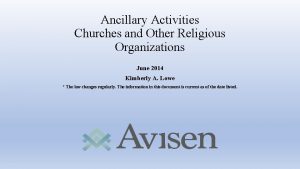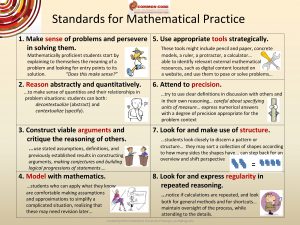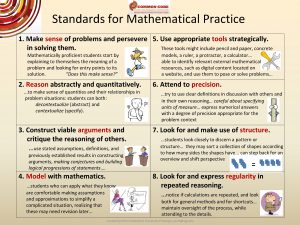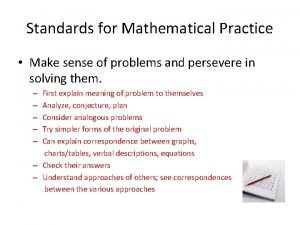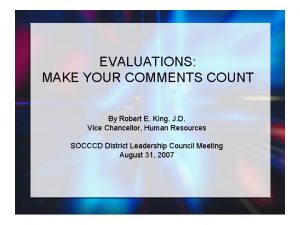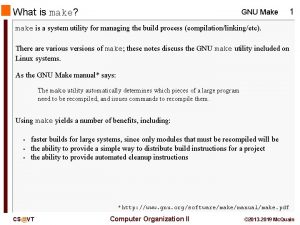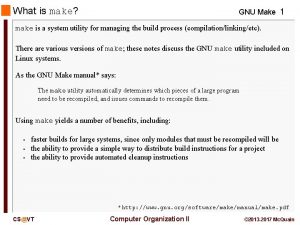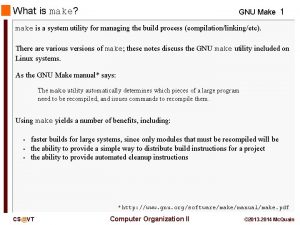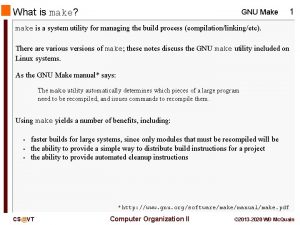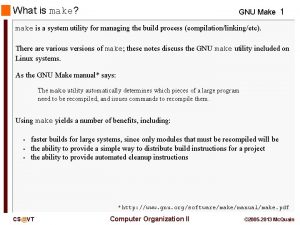Do Ancillary Services Make Sense for Your Practice






























- Slides: 30

Do Ancillary Services Make Sense for Your Practice? Tyler D. Artz, MHA, MBA, CMPE Director of Operations Department of Internal Medicine Saint Louis University

Introduction • What are ancillary services? • Why develop ancillary services? • How to evaluate ancillary services. • Strategic • Financial • Legal • Example • General Issues & Lessons Learned • Q&A

What are ancillary services? • Those services not directly related to the physician’s professional activity. – the technical portion of diagnostic testing, facility services, services provided by a nonphysician, etc. – Examples: ASC, MRI, CT, ultrasound, bone densitometry, audiology, infusion & so forth – Typically the service can be provided without or with less physician direct involvement.

Why develop ancillary services? • It’s the money – too simple. • Practice expenses have risen 6. 5% annually for • the past 10 years, easily out growing revenue. “Inability to generate new sources of revenue will lead to practice insolvency. ” -- William Jessee, MD, CEO, MGMA • “ancillary services” -- 2, 201 hits on MGMA article archives

How to evaluate ancillary services. • Strategic Issues – – – Diversification guideline External demand Internal compatibility • Financial Issues – Assumptions – Pro forma Income Statement & Evaluation • Legal Issues – – – Stark Law & Federal Anti-Kickback Law State Laws & CON Corporate Law • Example

Strategic Issues • Diversification guideline – Production Process • Physician vs. Clinical team vs. Kitchen – Delivery channel • Office vs. Hospital vs. ASC vs. Restaurant – Consumer • Patient vs. Health Plan vs. Family of four – “Never change more than one leg at a time. ”

Strategic Issues • External demand – Describe the target market. – 24 -38 year old, married women, without child – Endometriosis (ICD-9 -CM: 617. 0 -. 9), dual career couple, well educated, well insured, higher income – Measure the market. – CDC, Health Dept. , vendors, market research, etc. – Access the market – marketing plan. – Current patients, referral sources, advertising – Competition – current provider of service. – Compare your strengths/weaknesses with competition – Profile of market and its attractiveness.

Strategic Issues • Internal compatibility – Fits into an overall strategy. – Complements the organization’s culture. – Draws on the organization’s strengths. – Matches the organization’s risk tolerance. – Should be natural extension of core business. – Great ancillary services won’t compensate for poor professional performance.

Financial Issues • Assumptions – Volume / units of service • External demand profile – payer mix, demo. , etc. • Current patient conversions • By CPT code / procedure – per unit – Operating Revenue • Charge per unit – survey data, % of MCR allow. • Payment per unit – self pay/MCR/CP, payer mix

Financial Issues • Assumptions – Operating Expenses • Staff – by position, salary, benefits • Supplies – medical, office, other • Insurance – malpractice, P & C • Space – rent or equivalent • Marketing – if necessary, brochures, advertising • Capital – current portion – rent, amort/depr or P & I • Total operating expenses per unit

Financial Issues • Assumptions – Capital Investment • Hard costs – equipment, construction, land, etc. • Soft costs – legal, consultants, architects, appraisals, installation, inspections, broker fees, commissions, deliver/handling, etc. • Interim interest – cost during development period • Working capital – operating costs during initial collection cycle • Total project cost

Financial Issues • Assumptions – Project Financing • Local bank – equipment, real estate, WC loan • Capital partnership – equipment, real estate • Specialty lenders – equipment, vendors, REIT, mortgage financing, landlord • Depreciation / amortization / tax consequences • Determine annual cost given project financing

Financial Issues • Pro forma Income Statement – All financial elements converge. – Represents expected performance. • Evaluation – – – Break even point – fixed and variable costs Return on investment Margin analysis, unit analysis Incremental vs. full costing impact Operating vs. capital cost analysis Sensitivity analysis, risk tolerance

Legal Issues • Stark law – restricts physician referrals – Prohibits referral to DHS if physician has ownership in DHS – Clinical labs, PT, diagnostic radiology, I/P & O/P services – Exceptions • In-office ancillary services • Nuclear medicine, ASC investments, certain diagnostic services • Shared facilities • Continuously changing

Legal Issues • Federal Anti-kickback law – Prohibits remuneration for referring or arranging referrals in exchange for federal health care program patients. – Assure transactions are based on FMV and are not linked to volume or value of referrals. • State laws – Restrict ownership, referrals, and other transactions.

Legal Issues • Certificate of Need, Licensure & MCR Cert. – CON: regulates facility and service development. Spending thresholds, new service limitations. Dead in many states, alive in Missouri. – Licensure: State Dept of Health – MCR Certification: required for MCR facility payment • Joint ventures, shared facilities, and management arrangement – Creative relationships for offering new service

Legal Issues • Corporate Structure – ownership entity • Corporation • Partnership • Limited Liability Corporation (LLC) • Leases • Contracts

Legal Issues – legal guideline ♦ RETAIN A DEAL MAKING LAWYER. ♦ GET RECOMMENDATION FROM PEERS WHO HAVE DONE THE SAME PROJECT. ♦ INCLUDE LAWYER EXPERIENCED WITH YOUR KIND OF PROJECT FROM START. ♦ THE BEST DOLLARS SPENT. ♦ AVOID JAIL TIME & C. L. G. ’s.

Example – purchase CT Scanner • Strategic – – – 50 physician multi-specialty group. GOAL: Expand internal scope of services. Group operates existing radiology service. Move scans from hospital to in-house service. Currently perform 8 O/P scans per day in hospital. Group responsible for 95% of radiology cases. – – 100% ownership through group partnership. Building landlord will provide build out in new lease. 90% of scanner’s cost financed by local bank loan. Group will pay 10% of scanner’s cost and other incidentals from operating cash and reserves. • Financial

Example – purchase CT Scanner • Legal – – – Qualifies for Stark in office exemption. Below CON spending and service threshold. No facility licensure or certification required. – No restrictive covenants with hospital or others.

CT pro forma Assumptions

CT pro forma Assumptions

CT pro forma Assumptions

CT pro forma Assumptions

CT pro forma Assumptions



General Issues • When do you use a consultant? • How do you pick a joint venture partner? • When is the cost of a technological advantage worth while? • Understand a project’s “secondary value”.

Lessons Learned • Know your target market. • Know your reimbursement and costs. • Know your risks, and know the law. • Be realistic, don’t be greedy. • Be creative. • Be persistent. • Assemble the right team.

Questions & Answers
 Narrow sense heritability vs broad sense heritability
Narrow sense heritability vs broad sense heritability Narrow sense heritability vs broad sense heritability
Narrow sense heritability vs broad sense heritability Ancillary industrial estate
Ancillary industrial estate Ancillary activities examples
Ancillary activities examples Descriptive categories for wisc-v
Descriptive categories for wisc-v Ancillary controls aircraft
Ancillary controls aircraft Ancillary space
Ancillary space Ancillary documents
Ancillary documents Ancillary charge eon
Ancillary charge eon Ancillary facilities construction
Ancillary facilities construction Ancillary probate colorado
Ancillary probate colorado Aaapl
Aaapl What is the difference between a phrase and a clause
What is the difference between a phrase and a clause Spell makes sense
Spell makes sense Uil math practice tests middle school
Uil math practice tests middle school Give us your hungry your tired your poor
Give us your hungry your tired your poor Fspos
Fspos Novell typiska drag
Novell typiska drag Nationell inriktning för artificiell intelligens
Nationell inriktning för artificiell intelligens Ekologiskt fotavtryck
Ekologiskt fotavtryck Varför kallas perioden 1918-1939 för mellankrigstiden?
Varför kallas perioden 1918-1939 för mellankrigstiden? En lathund för arbete med kontinuitetshantering
En lathund för arbete med kontinuitetshantering Underlag för särskild löneskatt på pensionskostnader
Underlag för särskild löneskatt på pensionskostnader Personlig tidbok
Personlig tidbok A gastrica
A gastrica Förklara densitet för barn
Förklara densitet för barn Datorkunskap för nybörjare
Datorkunskap för nybörjare Boverket ka
Boverket ka Hur skriver man en debattartikel
Hur skriver man en debattartikel Autokratiskt ledarskap
Autokratiskt ledarskap Nyckelkompetenser för livslångt lärande
Nyckelkompetenser för livslångt lärande



